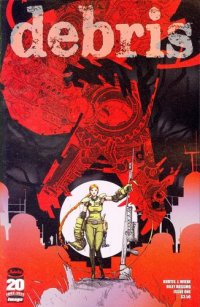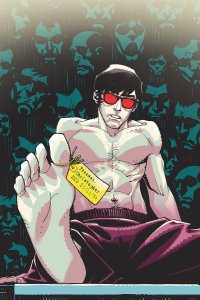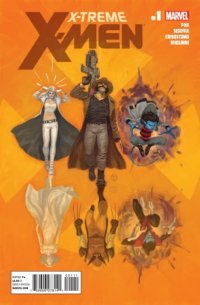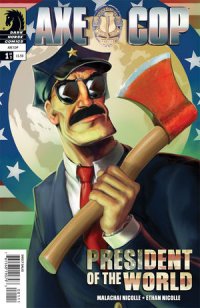Debris #1 ($3.50, Image)
by D.S. Randlett (@dsrandlett)
One thing about the post-Buffy strong female character: she’s always written by a dude. In most respects, Debris is a truly delightful comic book. It’s a solid young adult fantasy action yarn with great art, but more on its merits in a second. The book has a pretty major flaw that holds it back from being something great, and it’s a flaw that’s pretty endemic among this particular sub genre: the writer is content to stick to a set of modern “strong young female character” tropes instead of writing actual characters. Including strong heroines in genre fiction is an incredibly laudable goal, and it should be pursued. But judging from work like Debris and others like Monkeybrain’s Amelia Cole, we’re content to write characters that appear female, but could easily be drawn as males without changing any of the story’s feel. The problem with how books like these handle their female principles is the very same problem that beleaguers books with male protagonists: they are essentially neutered and bereft of identity. I’m reminded of how cool I thought it was that I could essentially download any character ever made to play Quake 3, but it never changed how the game felt, I would just swap out an appearance. This is what happens with character like Maia (the principle here) or Amelia Cole, we’re writing women heroines according to a faulty set of rules invented for male heroes. They are not people, they are task accomplishers.
If the goal is to create new role models for young women, all that we’re willing to cater to is their sense of cool. And make no mistake, doing ninja backflips to stab giant junkyard snakes in the eye is very cool, especially when it’s as well drawn as it is here. But what does it mean to be a woman in this rather compelling new world that the creators of this series have dreamed up? Even though the aim of this series appears to build a unique world and spin a yarn, the characters feel empty. The eyes through which we view this world have no content besides that of “generic hero”.
But where Debris succeeds, it succeeds wildly. The art, by Riley Rossmo, is pretty jaw dropping. It fits the young adult sensibilities of the story quite well. His style here has a very European feel, helped by a bright, washed out pallette. The world, presumably the creation of writer Kurtis J. Wiebe, is brought to vivid life. by Rossmo’s assured sense of style. Rossmo also has a great eye for action here, really conveying a sense of movement and momentum whenever things heat up.
Wiebe, even though he fumbles on the characters a fair bit, has created a fun and unique spin on the YA post-apocalypse. It’s never said how society collapsed, but it appears that it has something to do with these animal spirits that build bodies for themselves out of junkyard trash. It actually sounds kind of awful, but it’s a really slick visual, and the monster fights are a lot of fun. The plot concerns Maia, who having just come of age is made the protector of the last tribe of humans on Earth. Her task is to deal with these aforementioned animal-robot monsters, but when disaster strikes she must leave to find something that could determine the fate of her tribe. So, for all that I complained about this book earlier: I still want to see what happens, if only so that I can get more of Rossmo’s art over the coming months.
Rating: 




Out of a Possible 5 Stars
 National Comics: Eternity One-Shot (DC, $3.99)
National Comics: Eternity One-Shot (DC, $3.99)
by Graig Kent
For a few years now over at Image Comics the Top Cow imprint has been running, with seeming success, a comic-book testbed called “Pilot Season”. In case you don’t know, it’s loosely based off the television phenomena of “pilot season” wherein television networks push a small selection of their new programming pitches into a one-episode production (called a pilot) to decide if they want to push the show to series. With Top Cow’s Pilot Season, the publisher each year runs (typically) six one-shots as proving-grounds for new series, with the winners being decided by the reading public.
While this month’s “National Comics” series of one-shots from DC isn’t exactly a cop of Top Cow’s formula (and could just well be the latest round of DC’s trademark maintenance) this first of four efforts in the line certainly feels like a pilot. Like any solid first episode for a new television program, National Comics: Eternity introduces its central character, the environment in which they work, hints at what makes them tick, and the crux of what the series would be, even introducing some plot twists and an ending with a question mark (perhaps leaving you wanting more?). More so than most comic book first issues, Eternity feels like a proper television pilot, it certainly meets all the expected beats of formulaic TV.
Written by Jeff Lemire, with art by Cully Hamner, the book plays with an old character in the DC stable — as all four National Comics will, in this case Kid Eternity — and twists it on its ear into a much different setup. Created in 1946, the original Kid Eternity was a soldier who the powers that be decided had died too soon, so they gave him life once more and the ability to summon any historical figure to aide him in his spiritually mandated quest to do good, guided along the way by his spirit mentor Mr. Keeper. This book turns the character concept into an rote CBS supernatural detective drama that blends equal parts Quincey, The Ghost Whisperer, CSI, The Mentalist and any of dozens of other such formulaic of-the-week shows. Here police coroner Christopher Freeman has gained the power to call upon the spirit of the recently dead for 24 hours after almost dying himself when his father was gunned down before him. In this one-shot, Chris uses his ability to recall the spirits of murder victims and help solve the mystery of their death (you know, the easy way, instead of doing his job properly).
It’s quite shocking how rote and formulaic this book is, which is equally its appeal, and its greatest weakness. Lemire actually does a remarkable job creating an interesting central character, twisting the Kid Eternity conceit whilst still keeping ties to it, and introducing seeds that would grow into story lines of their own were this an ongoing series, but it still feels like overtly familiar material, something that has been done before time and time again. There’s a comfort in that familiarity, but at the same time I wouldn’t regularly watch a show like this for free on television, and I definitely wouldn’t pay to read one on a monthly basis. It is wholly accessible though. Were this a regular series, it would totally be a comic my mom could get into, and what’s more it’s completely ready for prime time. Extend this issue to 44 minutes of small screen time, add in an oddball in either mentor or assistant form and perhaps a neighbor or best friend character, and you’ve got yourselves a new hit for the 49 – 65 demographic.
Rating: 




Out of a Possible 5 Stars
X-Treme X-Men #1 (Marvel, $3.99)
By Jeb D.
The post-Claremont X-Men have thrived on a combination of soap opera, social metaphor and superhero punchups. But the constantly-burgeoning cast, and multiversity-heavy canvas, also allowed writers like Peter Milligan, and Judd Winick to veer off the mainstream to construct imaginative, time-spanning, dimension-hopping storylines in books like Exiles and X-Statix. Rather than serve as the successor to Chris Claremont’s X-treme book of a few years ago, this new title from writer Greg Pak looks to those series for inspiration. A bit oddly, X-Treme X-Men #1 picks up right at the end of Pak’s run on Astonishing X-Men; on the one hand, it certainly hits the ground running, but for those of us who haven’t kept up on AXM, it can be a bit jarring to be shown, say, dozens of floating Xavier heads, without a more formal introduction. And while it would seem that Pak intends a happy-go-lucky superhero romp, with fun juxtapositions of familiar characters in new contexts, he’s off to a bit of a sloppy start.
Pak’s AXM team of Emmeline Frost, General Howlett, Kurt Waggoner, and Shadow are joined here by Dazzler (one of those characters that every writer is just sure they can finally make work) in a storyline that suggest it’s going to examine the difficulties of managing a world (or a universe) that you’ve just helped save, but Pak gets a bit bogged down in Alison Blaire’s character. Rock and roll rarely works particularly well on the printed page; it tends to feel forced and awkward (even when it doesn’t come from a character who began as a roller-skating disco queen), and though artist Stephen Segovia manages to illustrate guitar fingering with a semblance of verisimilitude, having Dazzler hold off a giant squid with the “blang!” of a power chord, and a rallying cry of “This B-side totally rocks!” is about as cringe-worthy as it gets (and her cutesy rom-com banter with another musician is roughly one-third as endearing as Pak seems to think it is).
Elsewhere, the team faces down an interdimensional threat (the aforementioned squid), while having an interminably talky meeting with some counterparts from the regular Marvel U; this sequence is one of several places in the book where Pak and Segovia pay homage to some of their more sci-fi oriented predecessors (Planetary comes particularly to mind). In fact, at least visually, most of the big-picture stuff works pretty well: Segovia is at his best when working on a large scale, and he brings proper drama, along with a frisson of fun, to the final-page splash. Otherwise, though, he’s a bit inconsistent, particularly with character proportions.
I wouldn’t normally be terribly disappointed in an unsatisfying X-Men series (after all, there’s always another one right around the corner), but Pak is one of Marvel’s best writers (and one of the few that really seemed to get what Morrison’s New X-Men was all about in his Phoenix: Endsong series a few years back), so I don’t think it’s unreasonable to have had relatively high hopes for this one going in. By specifying that X-treme X-men takes place prior to the current Avengers – X-men crossover, Marvel more or less invites readers to simply sit back and enjoy the ride, but Pak needs to get a firmer grip on his story before that’s going to happen.
Rating: 




Out of a Possible 5 Stars
 Axe Cop: President of the World #1 ($3.50, Dark Horse)
Axe Cop: President of the World #1 ($3.50, Dark Horse)
by D.S. Randlett (@dsrandlett)
Why isn’t this joke old yet? Axe Cop has been a webcomics staple for me for the past few years now, but I have had to take a break from this mad world, as its energy can actually be draining. When Axe Cop started, it was a riot because you could tell that the younger half of this creative team, the now eight years old Malachai Nicolle, really thought that this stuff was awesome. There’s a sort of anarchic glee in the way that Axe Cop tends to unfold. Malachai’s hero has to always win, and the logic of these stories unfolds in the same way as those old schoolyard games where everyone would just absolutely refuse to lose. Remember when you’d be Indiana Jones while your friend would be Godzilla, and you would come up with some way that Indiana Jones couldn’t be crushed by Godzillas? That’s basically Axe Cop in a nutshell, and it’s hilarious.
President of the World is the first Axe Cop that I’ve read for about a year. I figured that a time would come when Malachai would become old enough to be in on the joke, but it seems that it hasn’t quite arrived just yet. And well, it’s certainly an Axe Cop comic, which is probably all that you need to know.
31 year-old brother Ethan certainly helps it all hang together. He has an uncanny ability to convey the goofiness of his younger brother’s imagination while making it seem like these characters really “believe it.” Axe Cop himself takes his work extremely seriously, and as a character is all business and completely humorless, which is why he’s so damn funny. A certain guffaw-inducing moment happens during a press conference, when a reporter asks if this is “the end of all bad guys.” Axe Cope replies, “I will ask God for the answer to that question and get back to you.” Axe Cop and his writer are completely serious about this, and it’s a marvel that the art can capture both that belief and the humor of it at once.
I love it, but your mileage may vary depending on how you feel about the Axe Cop concept.
Rating: 




Out of a Possible 5 Stars